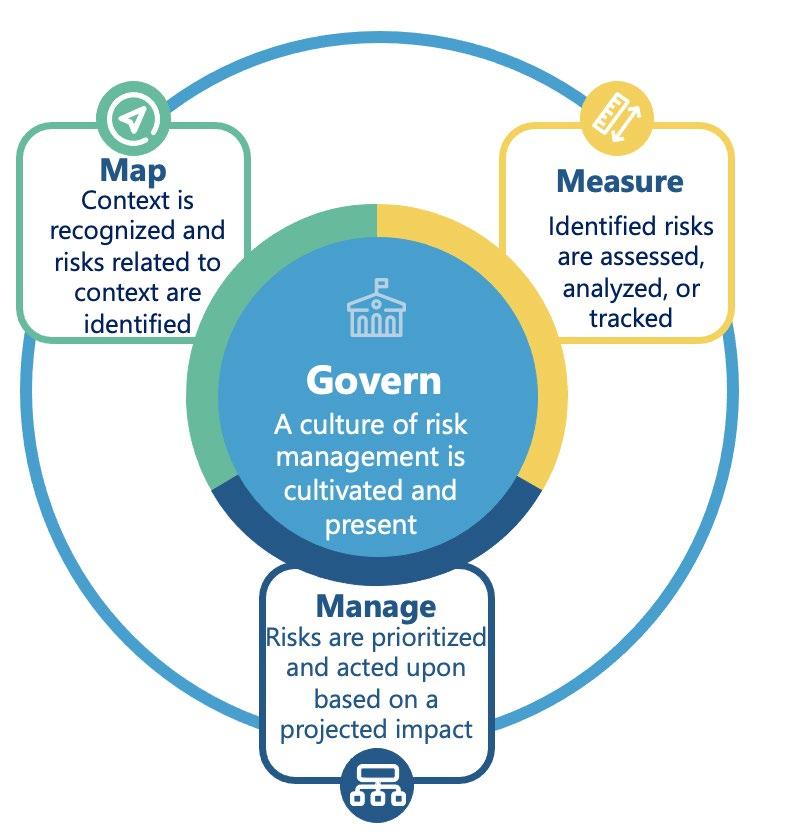
4 minute read
APPENDIX A: DESCRIPTIONS OF AI ACTOR TASKS FROM FIGURE 1
Appendix A: Descriptions of AI Actor Tasks from
Figure 1
Advertisement
AI Design includes AI actors who are responsible for the planning, design, and data collection and processing tasks of the AI system. Tasks include articulating and documenting the system’s concept and objectives, underlying assumptions, context, and requirements; gathering and cleaning data; and documenting the metadata and characteristics of the dataset. AI actors in this category include data scientists, domain experts, socio-cultural analysts, human factors experts, governance experts, data engineers, data providers, and evaluators. AI Development includes AI actors who are responsible for model building and interpretation tasks, which involve the creation, selection, calibration, training, and/or testing of models or algorithms. Tasks involve machine learning experts, data scientists, developers, and experts with familiarity about the socio-cultural and contextual factors associated with the deployment setting. AI Deployment includes AI actors who assure deployment of the system into production. Related tasks include: piloting, checking compatibility with legacy systems, ensuring regulatory compliance, managing organizational change, and evaluating user experience. AI actors in this category include system integrators, software developers, evaluators and domain experts with expertise in human factors, socio-cultural analysis, and governance. Operation and Monitoring includes AI actors who are responsible for operating the AI system and working with others to continuously assess system output and impacts. Users who interpret or incorporate the output of AI systems, evaluators and auditors, and members of the research community are part of this group. Test, Evaluation, Verification, and Validation (TEVV) tasks are performed by AI actors who examine the AI system or its components, or detect and remediate problems throughout the AI lifecycle. Tasks can be incorporated into a phase as early as design, where tests are planned in accordance with the design requirement. ● TEVV tasks for design, planning, and data may center on internal and external validation of assumptions for system design, data collection, and measurements, relative to the intended context of deployment or application. ● TEVV tasks for development (i.e., model building) include model validation and assessment. ● TEVV tasks for deployment include system validation and integration in production, with testing, tuning, and recalibration for systems and process integration, user experience, and compliance with existing legal, regulatory, and ethical specifications. ● TEVV tasks for operations involve ongoing monitoring for periodic updates, testing, and recalibration of models, and the detection of emergent properties and related impacts.
Human Factors tasks and activities include human-centered design practices and methodologies, promoting the active involvement of end-users and appropriate stakeholders, incorporating context-specific norms and values in system design (VSD), evaluating and adapting end-user experiences, and broad integration of humans and human dynamics in all phases of the AI lifecycle. Human factors professionals provide multidisciplinary skills and perspectives to understand context of use, engage multi-stakeholder processes, design and evaluate user experience (UI/UX), perform human-centered evaluation and testing, and inform impact assessments. Domain Experts are multidisciplinary practitioners or scholars who provide knowledge or expertise in an industry sector, economic sector, or application area where an AI system is being used. These experts are essential contributors for AI system design and development and can provide interpretation of outputs to support the work of TEVV and AI impact assessment teams. AI Impact Assessors are responsible for assessing and evaluating requirements for AI system accountability, combating harmful bias, examining intended and unintended impacts of AI systems, product safety, liability, and security, among others. AI Impact assessors provide technical, human factor, socio-cultural, and legal expertise. Procurers are financial, legal, or policy management officials who acquire AI models, products, or services from a third party, developer, vendor, or contractor. Third-party entities are providers, developers, or vendors of data, algorithms, models, and/or systems and related services to another organization or the organization’s customers or clients. Third-party entities are responsible for AI design and development tasks, in whole or in part. By definition, they are external to the design, development, or deployment team of the organization that acquires its technologies or services. The technologies acquired from third-party entities may be complex or opaque, and risk tolerances may not align with the deploying or operating organization. Organizational Management, Senior Leadership, and the Board of Directors are among the parties responsible for AI governance. End Users of an AI system are the individuals or groups that use the system for a specific purpose. These individuals or groups interact with an AI system in a specific context. End users can range in competency from AI experts to first-time technology end-users. AI Operators continuously assess system recommendations and impacts (both intended and unintended) in light of the system’s objectives as well as the ethical considerations that go into its operation. Operators can often be associated with the planning and design or specification stage of the AI system lifecycle as well as post-deployment monitoring. Affected Individuals/Communities encompass any individual, group, community, or stakeholder organization affected by AI systems or decisions based on the output of AI systems,
directly or indirectly. These individuals do not necessarily interact with the system and can be indirectly or directly affected by the deployment of an AI system or application.
Other AI actors may provide formal or quasi-formal norms or guidance for specifying and managing AI risks. They can include trade groups, standards developing organizations, advocacy groups, environmental groups, and civil society organizations.
The general public is most likely to directly experience positive and negative impacts of AI technologies. They may provide the motivation for actions taken by the other stakeholders and can include individuals, communities, and consumers in the context where an AI system is developed or deployed.





